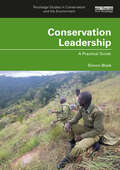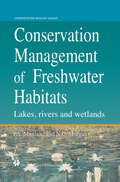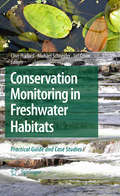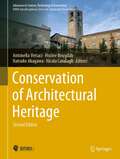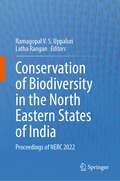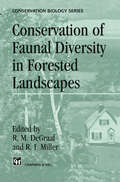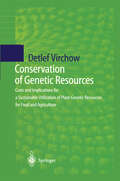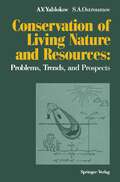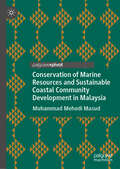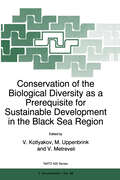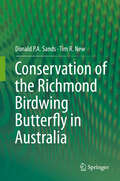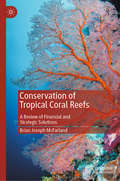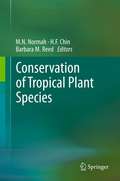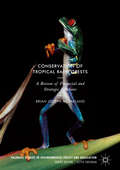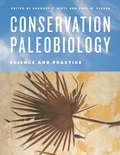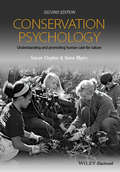- Table View
- List View
Conservation Leadership: A Practical Guide (Routledge Studies in Conservation and the Environment)
by Simon BlackThis book is an important guide for individuals seeking to develop and grow their leadership skills in the wildlife conservation sector, across varied disciplines such as environmental management, conservation biology, and ecotourism.Conservation Leadership addresses what leadership is, why it is important, and how to be an effective leader. It identifies the common pitfalls or mistakes in a leader’s thinking or behaviour, and the unexpected consequences or responses which can arise, and then explores more helpful alternative approaches to leadership. The book is divided into three parts: Part I: Leadership principles Part II: Four areas of profound theory: knowledge, psychology, systems, and variation Part III: Skills and competencies for conservation leaders It focuses on contextual and organisational challenges in conservation, including limited resources, remote locations, fragile species of concern, politics, community conflict, crime, and commercial pressures. The scope is global, using diverse examples such as sea turtle head-starting in South Asia, reforestation in North Africa, bird conservation in North America, human–wildlife interactions in the Himalayas, and post-colonial issues in the Caribbean. Case studies illustrate key learning points from small local teams through to global transnational initiatives. Exercises in each chapter enable the exploration of less-familiar topics, including interpersonal skills, goal setting and performance measurement, plus a unique research-derived conservation leadership self-assessment tool.This book is an essential reading resource for professionals and senior leaders in the wildlife management and conservation sector, as well as students on biodiversity conservation, wildlife conservation, and environmental management courses.
Conservation Leadership: A Practical Guide (Routledge Studies in Conservation and the Environment)
by Simon BlackThis book is an important guide for individuals seeking to develop and grow their leadership skills in the wildlife conservation sector, across varied disciplines such as environmental management, conservation biology, and ecotourism.Conservation Leadership addresses what leadership is, why it is important, and how to be an effective leader. It identifies the common pitfalls or mistakes in a leader’s thinking or behaviour, and the unexpected consequences or responses which can arise, and then explores more helpful alternative approaches to leadership. The book is divided into three parts: Part I: Leadership principles Part II: Four areas of profound theory: knowledge, psychology, systems, and variation Part III: Skills and competencies for conservation leaders It focuses on contextual and organisational challenges in conservation, including limited resources, remote locations, fragile species of concern, politics, community conflict, crime, and commercial pressures. The scope is global, using diverse examples such as sea turtle head-starting in South Asia, reforestation in North Africa, bird conservation in North America, human–wildlife interactions in the Himalayas, and post-colonial issues in the Caribbean. Case studies illustrate key learning points from small local teams through to global transnational initiatives. Exercises in each chapter enable the exploration of less-familiar topics, including interpersonal skills, goal setting and performance measurement, plus a unique research-derived conservation leadership self-assessment tool.This book is an essential reading resource for professionals and senior leaders in the wildlife management and conservation sector, as well as students on biodiversity conservation, wildlife conservation, and environmental management courses.
Conservation Management of Freshwater Habitats: Lakes, rivers and wetlands (Conservation Biology #9)
by Neville C. Morgan Peter S. MaitlandIn this book the authors have applied research knowledge to the solution of practical problems facing wildlife conservation in freshwater habitats. Subjects covered include: evaluation of the conservation interest of sites; practical protection and management of freshwater habitats; species conservation.
Conservation Monitoring in Freshwater Habitats: A Practical Guide and Case Studies
by Clive Hurford Michael Schneider Ian CowxAs in the terrestrial environment, most data collection from freshwater habitats to date falls into the survey, surveillance or research categories. The critical difference between these exercises and a monitoring project is that a monitoring project will clearly identify when we need to make a management response. A Model for Conservation Management and Monitoring Monitoring (as defined by Hellawell) is essentially a tool of practical conservation management, and Fig. 1.1 shows a simple, but effective, model for nature conser- tion management and monitoring. The need for clear decision-making is implicit in this model. First we must decide what would represent a favourable state for the key habitat or species, and then we must decide when to intervene if the state is (or becomes) unfavourable. A third, often overlooked, but equally important, decision concerns when we would consider the habitat or species to have recovered; this is unlikely to be the same point that we became concerned about it. This decision not only has resource imp- cations, it can also have major implications for other habitats and species (prey species are an obvious example). All of these decisions are essential to the devel- ment of an efficient and effective monitoring project.
Conservation of Architectural Heritage (Advances in Science, Technology & Innovation)
by Hocine Bougdah Natsuko Akagawa Antonella Versaci Nicola CavalagliThis book focuses on the management and conservation of architectural heritage with the aim of increasing awareness about the value of such conservation and of saving what is left of history, which in turn rewards societies by supporting the tourism industry, generating economic return, and preserving communities’ identities.Since it has become an essential need to manage and conserve the architectural heritage in order to protect the identity and heritage of a city, there appeared a gap between the theory and its application. Therefore, a considerable amount of attention has been directed by experts in this field toward emphasizing the contribution of heritage conservation in order to inspire the development of imaginative, useful high-quality design.
Conservation of Biodiversity in the North Eastern States of India: Proceedings of NERC 2022
by Ramagopal V. S. Uppaluri Latha RanganThis volume presents part of the proceedings of NERC 2022, with an emphasis on conservation of bio-diversity in North-east India. This is a highly challenging and involved topic due to regionally diverse physiographic, geographical and eco-climatic conditions. Henceforth, systemic and holistic frameworks are required to disseminate upon the potential of science and technology for the conservation of the region’s bio-diversity. Notable among these frameworks refers to plant, microbial and animal bio-diversity conservation, value-added product development and sharing the benefits of such research for the perspective of bio-prospects, analysing critical environmental and climatic factors and their sensitivity upon urbanization strategies. Tools that are to be deployed for such insights involve plant, animal, and microbial bioscience and biotechnology, generalized rules for product design and development and survey based strategies. Addressing relevant competent methodologies and generic pedagogies, this volume on the bio-diversity conservation in North-eastern states of India aims to demonstrate the potential of pragmatic strategies that can be applied for the bio-diversity conservation in any region of world. Thereby, opportunities for nature linked livelihood security can be sought for the long term wellbeing of the humankind and ecology.
Conservation of Dragonflies: Sentinels for Freshwater Conservation
by Dr Michael J SamwaysDragonflies are among the most familiar and popular of all insects, deeply embedded in human cultural history. They are iconic and tell us much about the environments in which we and they live. Their conservation is an important part of biodiversity conservation. One modern dragonfly species is listed as extinct, with many others currently threatened. It is now essential to increase conservation efforts towards saving these threatened species, with strategies now available for doing this. Recovery of dragonfly populations goes hand in hand with improvements to both freshwater conditions and bank vegetation quality. In contrast, some other dragonfly species have benefitted greatly from human transformation of the landscape, with artificial ponds in particular, increasing the population levels of many species. In turn, climate change is seeing many geographical range shifts. Dragonflies are variously sensitive to the health of freshwater systems, and the quality of vegetation along rivers and around ponds. Dragonflies are excellent indicators in these times of great concern over the quality of our freshwater supplies. Their wide range of sensitivities enables us to measure the extent to which freshwater ecosystems are either deteriorating or are improving when we undertake restoration. They enable us to gauge how well we are conserving freshwaters, whether ponds and lakes, streams or rivers. They are also good umbrellas for many other freshwater inhabitants, which altogether reflect the health of a freshwater system. Conservation of Dragonflies: Sentinels for Freshwater Conservation is for naturalists, citizen scientists, entomologists and conservation scientists, as well as practitioners and policy makers around the world.
Conservation of Faunal Diversity in Forested Landscapes (Conservation Biology #6)
by Richard M. DeGraaf Ronald I. MillerForest wildlife conservation is critically required in many parts of the world today. This book presents a merger between the elements of wildlife conservation and habitat conservation, and explains how these disciplines can be used to promote the conservation of vertebrates in forests around the world.
Conservation of Genetic Resources: Costs and Implications for a Sustainable Utilization of Plant Genetic Resources for Food and Agriculture
by Detlef VirchowOver the past decade the importance of natural resources for sustainable agricultural development has been increasingly discussed at international forums and conferences. Aside from the sustainable management of soil, water, and air, it now seems to be accepted that the sustainable management of genetic resources is one of the four indispensable preconditions for a sustainable agriculture. The discussion on conservation of plant genetic resources for food and agriculture (PGRFA), however, has to reflect the costs of conservation as well. These have not yet been discussed intensively. The study analyzes the conservation costs of plant genetic resources; it also assesses the effectiveness of conservation and the efficiency of the different conservation instruments. It is based on extensive surveys in relevant countries. Following the detailed cost and impact analysis, the results show that the effectiveness of conservation strategies may be increased.
Conservation of Great Plains Ecosystems: Current Science, Future Options (Ecology, Economy & Environment #5)
by S. R. Johnson Aziz BouzaherA multidisciplinary and multifaceted approach is employed to identify principal ecosystems and natural resources in the U.S. Great Plains that are at risk and that should receive priority for protection. The authors are drawn from a variety of disciplines and approaches, their ideas being presented as a pooling or harvest, rather than as a consensus. The 25 chapters provide background and in-depth discussion of multiple issues/problems related to Great Plains stewardship for future generations. The status and trends of major resources of the Great Plains within an historical, ecological and management framework are categorized according to common goals across the disciplines and can be used to make recommendations for public policy, research and development, and institutions. The challenge for residents of the Great Plains is to merge multiple ecosystem concepts to improve the environment and to improve economic vitality.
Conservation of Living Nature and Resources: Problems, Trends, and Prospects
by Alexey V. Yablokov Sergey A. OstroumovThis book is based on our two books, published in the USSR and translated in a number of other countries Conservation of living nature: problems and perspectives (1983) and The levels of conservation of living nature (1985). It differs from the vast majority of the numerous books on conservation and environment, which are mainly devoted either to specific problems of conservation of certain taxons, or to problems of conservation of prescribed regions, or to general issues of environmental conservation in toto, while the problems of the conservation of living nature are represented only to a small degree. Our book is one of the volumes - at present not numerous - that place a high value on the diversity ofliving nature as the basis for the existence and development of mankind on the Earth. Living nature, besides its own intrinsic value, at all times was, is now and will ever remain the sole, unique and indispensable resource and provider for mankind.
Conservation of Marine Resources and Sustainable Coastal Community Development in Malaysia
by Muhammad Mehedi MasudThis book addresses a timely and compelling emerging issue related to the conservation and sustainable use of marine resources and the sustainable development of the coastal community. Marine protected areas (MPAs) make a remarkable contribution to the protection of marine communities by providing sustainable livelihoods, deriving financial benefits from the development of fisheries and tourism, as well as by restoring ocean productivity and preventing further environmental degradation. These areas have been considered the cornerstone of a blue economy due to their substantial economic, social and environmental contributions. However, MPAs around the world are severely hampered by a multitude of issues and challenges such as inefficient management, poor socioeconomic conditions and environmental degradation due to human activities, overexploitation of marine resources, degradation of water quality, massive waste production and climate change. These are the main obstacles to economic, social and environmental sustainability. Hence, a collaborative management approach and an integrated management policy framework is urgently needed for the economic, social, political, cultural, technological, and ecological development of coastal communities.
Conservation of the Biological Diversity as a Prerequisite for Sustainable Development in the Black Sea Region (NATO Science Partnership Subseries: 2 #46)
by V. Metreveli M. Uppenbrink V. KotlyakovThis volume is a collection of reports presented at the International NATO Advanced Research Workshop Conservation of the Biological Diversity as a Prerequisite for Sustainaible Development of the Black Sea Region. The seminar was held at Batumi - Kobuleti, Georgia, on the Black Sea during October 5 -12, 1996 with participants from the countries of the Black Sea Region -Georgia, Russia, the Ukraine, Turkey, Bulgaria, Romania, as well as Germany, Italy and the United States of America. The Black Sea Region is an essential and unique part of southern Europe because of its geographical, cultural and historical features. It is the cradle of European civilisation, together with Greece and Rome. For centuries it neighboured onto and interacted with the cultures of the northern and southern Mediterranean, the Christian and Moslim worlds, and was the route of conquerors and migrations of whole nations. Here are closely interwoven the cultures and customs of nations, economic and trade relations, the history of wars and civilised relations of neighbouring countries.
Conservation of the Richmond Birdwing Butterfly in Australia
by Donald P.A. Sands Tim R. NewThis survey of one the longest insect conservation campaigns in Australia deals with recovery of one of the most iconic endemic butterflies, the Richmond birdwing, threatened by clearance and fragmentation of subtropical rainforest in eastern Australia and the spread of an alien larval food-plant. Its conservation has involved many aspects of community involvement, developed over more than 20 years, and focused on habitat restoration and weed eradication, in conjunction with conservation of remaining forest fragments. The work has involved the entire historical range of the butterfly, addressed threats and emphasised landscape connectivity, and has enhanced recovery through extensive plantings of native food plants. Interest has been maintained through extensive publicity, community education and media activity, and the programme has provided many lessons for advancing insect conservation practice in the region.
Conservation of Tropical Coral Reefs: A Review of Financial and Strategic Solutions
by Brian Joseph McFarlandThis book critically engages with how the conservation of tropical coral reefs is financed. Beginning with the context of tropical coral reef degradation and loss, alongside an overview of tropical ecology, global environmental policy and finance, the book reviews several conservation financing instruments. These include ecotourism, debt-for-nature swaps, impact investments, and government domestic budgetary expenditures. From the Great Barrier Reef, to the Coral Triangle, to the Mesoamerican Reef, tropical coral reef degradation and loss are serious global environmental issues, contributing to loss revenue and food insecurity for coastal communities, and species extinction. Yet, many leading companies, individuals, and governments are making a positive impact on tropical coral reef conservation through the use of conservation finance. Conservation of Tropical Coral Reefs, using 30 case studies which span 23 countries and 6 continents, tells the history of international conservation finance and provides a variety of options for individuals, businesses, and governments to support conservation financing projects.
Conservation of Tropical Plant Species
by M.N. Normah, H.F. Chin and Barbara M. ReedThe book is designed to provide a review on the methods and current status of conservation of the tropical plant species. It will also provide the information on the richness of the tropical plant diversity, the need to conserve, and the potential utilization of the genetic resources. Future perspectives of conservation of tropical species will be discussed. Besides being useful to researchers and graduate students in the field, we hope to create a reference for a much wider audience who are interested in conservation of tropical plant diversity.
Conservation of Tropical Rainforests: A Review of Financial and Strategic Solutions (Palgrave Studies in Environmental Policy and Regulation)
by Brian Joseph McFarlandThis book critically engages with how the conservation of tropical rainforests is financed. Beginning with the context of tropical deforestation, alongside an overview of tropical ecology, global environmental policy and finance, the book reviews several conservation financing instruments. These include ecotourism and private reserves, debt-for-nature swaps and government domestic budgetary expenditures for state and national parks. Tropical deforestation and forest degradation are serious global environmental issues, contributing to global climate change, species extinction, and threatening the livelihoods of forest-dependent communities. Yet, many leading companies, individuals and governments are making a positive impact on tropical forest conservation to mitigate greenhouse gas emissions through the use of conservation finance. Conservation of Tropical Rainforests tells the history of international conservation finance and provides a variety of options for individuals, businesses, and governments to support conservation financing projects.
Conservation Paleobiology: Science and Practice
by Gregory P. Dietl Karl W. FlessaIn conservation, perhaps no better example exists of the past informing the present than the return of the California condor to the Vermilion Cliffs of Arizona. Extinct in the region for nearly one hundred years, condors were successfully reintroduced starting in the 1990s in an effort informed by the fossil record—condor skeletal remains had been found in the area’s late-Pleistocene cave deposits. The potential benefits of applying such data to conservation initiatives are unquestionably great, yet integrating the relevant disciplines has proven challenging. Conservation Paleobiology gathers a remarkable array of scientists—from Jeremy B. C. Jackson to Geerat J. Vermeij—to provide an authoritative overview of how paleobiology can inform both the management of threatened species and larger conservation decisions. Studying endangered species is difficult. They are by definition rare, some exist only in captivity, and for those still in their native habitats any experimentation can potentially have a negative effect on survival. Moreover, a lack of long-term data makes it challenging to anticipate biotic responses to environmental conditions that are outside of our immediate experience. But in the fossil and prefossil records—from natural accumulations such as reefs, shell beds, and caves to human-made deposits like kitchen middens and archaeological sites—enlightening parallels to the Anthropocene can be found that might serve as a primer for present-day predicaments. Offering both deep-time and near-time perspectives and exploring a range of ecological and evolutionary dynamics and taxa from terrestrial as well as aquatic habitats, Conservation Paleobiology is a sterling demonstration of how the past can be used to manage for the future, giving new hope for the creation and implementation of successful conservation programs.
Conservation Paleobiology: Science and Practice
by Gregory P. Dietl Karl W. FlessaIn conservation, perhaps no better example exists of the past informing the present than the return of the California condor to the Vermilion Cliffs of Arizona. Extinct in the region for nearly one hundred years, condors were successfully reintroduced starting in the 1990s in an effort informed by the fossil record—condor skeletal remains had been found in the area’s late-Pleistocene cave deposits. The potential benefits of applying such data to conservation initiatives are unquestionably great, yet integrating the relevant disciplines has proven challenging. Conservation Paleobiology gathers a remarkable array of scientists—from Jeremy B. C. Jackson to Geerat J. Vermeij—to provide an authoritative overview of how paleobiology can inform both the management of threatened species and larger conservation decisions. Studying endangered species is difficult. They are by definition rare, some exist only in captivity, and for those still in their native habitats any experimentation can potentially have a negative effect on survival. Moreover, a lack of long-term data makes it challenging to anticipate biotic responses to environmental conditions that are outside of our immediate experience. But in the fossil and prefossil records—from natural accumulations such as reefs, shell beds, and caves to human-made deposits like kitchen middens and archaeological sites—enlightening parallels to the Anthropocene can be found that might serve as a primer for present-day predicaments. Offering both deep-time and near-time perspectives and exploring a range of ecological and evolutionary dynamics and taxa from terrestrial as well as aquatic habitats, Conservation Paleobiology is a sterling demonstration of how the past can be used to manage for the future, giving new hope for the creation and implementation of successful conservation programs.
Conservation Paleobiology: Science and Practice
by Gregory P. Dietl and Karl W. FlessaIn conservation, perhaps no better example exists of the past informing the present than the return of the California condor to the Vermilion Cliffs of Arizona. Extinct in the region for nearly one hundred years, condors were successfully reintroduced starting in the 1990s in an effort informed by the fossil record—condor skeletal remains had been found in the area’s late-Pleistocene cave deposits. The potential benefits of applying such data to conservation initiatives are unquestionably great, yet integrating the relevant disciplines has proven challenging. Conservation Paleobiology gathers a remarkable array of scientists—from Jeremy B. C. Jackson to Geerat J. Vermeij—to provide an authoritative overview of how paleobiology can inform both the management of threatened species and larger conservation decisions. Studying endangered species is difficult. They are by definition rare, some exist only in captivity, and for those still in their native habitats any experimentation can potentially have a negative effect on survival. Moreover, a lack of long-term data makes it challenging to anticipate biotic responses to environmental conditions that are outside of our immediate experience. But in the fossil and prefossil records—from natural accumulations such as reefs, shell beds, and caves to human-made deposits like kitchen middens and archaeological sites—enlightening parallels to the Anthropocene can be found that might serve as a primer for present-day predicaments. Offering both deep-time and near-time perspectives and exploring a range of ecological and evolutionary dynamics and taxa from terrestrial as well as aquatic habitats, Conservation Paleobiology is a sterling demonstration of how the past can be used to manage for the future, giving new hope for the creation and implementation of successful conservation programs.
Conservation Paleobiology: Science and Practice
by Gregory P. Dietl and Karl W. FlessaIn conservation, perhaps no better example exists of the past informing the present than the return of the California condor to the Vermilion Cliffs of Arizona. Extinct in the region for nearly one hundred years, condors were successfully reintroduced starting in the 1990s in an effort informed by the fossil record—condor skeletal remains had been found in the area’s late-Pleistocene cave deposits. The potential benefits of applying such data to conservation initiatives are unquestionably great, yet integrating the relevant disciplines has proven challenging. Conservation Paleobiology gathers a remarkable array of scientists—from Jeremy B. C. Jackson to Geerat J. Vermeij—to provide an authoritative overview of how paleobiology can inform both the management of threatened species and larger conservation decisions. Studying endangered species is difficult. They are by definition rare, some exist only in captivity, and for those still in their native habitats any experimentation can potentially have a negative effect on survival. Moreover, a lack of long-term data makes it challenging to anticipate biotic responses to environmental conditions that are outside of our immediate experience. But in the fossil and prefossil records—from natural accumulations such as reefs, shell beds, and caves to human-made deposits like kitchen middens and archaeological sites—enlightening parallels to the Anthropocene can be found that might serve as a primer for present-day predicaments. Offering both deep-time and near-time perspectives and exploring a range of ecological and evolutionary dynamics and taxa from terrestrial as well as aquatic habitats, Conservation Paleobiology is a sterling demonstration of how the past can be used to manage for the future, giving new hope for the creation and implementation of successful conservation programs.
Conservation Paleobiology: Science and Practice
by Gregory P. Dietl and Karl W. FlessaIn conservation, perhaps no better example exists of the past informing the present than the return of the California condor to the Vermilion Cliffs of Arizona. Extinct in the region for nearly one hundred years, condors were successfully reintroduced starting in the 1990s in an effort informed by the fossil record—condor skeletal remains had been found in the area’s late-Pleistocene cave deposits. The potential benefits of applying such data to conservation initiatives are unquestionably great, yet integrating the relevant disciplines has proven challenging. Conservation Paleobiology gathers a remarkable array of scientists—from Jeremy B. C. Jackson to Geerat J. Vermeij—to provide an authoritative overview of how paleobiology can inform both the management of threatened species and larger conservation decisions. Studying endangered species is difficult. They are by definition rare, some exist only in captivity, and for those still in their native habitats any experimentation can potentially have a negative effect on survival. Moreover, a lack of long-term data makes it challenging to anticipate biotic responses to environmental conditions that are outside of our immediate experience. But in the fossil and prefossil records—from natural accumulations such as reefs, shell beds, and caves to human-made deposits like kitchen middens and archaeological sites—enlightening parallels to the Anthropocene can be found that might serve as a primer for present-day predicaments. Offering both deep-time and near-time perspectives and exploring a range of ecological and evolutionary dynamics and taxa from terrestrial as well as aquatic habitats, Conservation Paleobiology is a sterling demonstration of how the past can be used to manage for the future, giving new hope for the creation and implementation of successful conservation programs.
Conservation Paleobiology: Science and Practice
In conservation, perhaps no better example exists of the past informing the present than the return of the California condor to the Vermilion Cliffs of Arizona. Extinct in the region for nearly one hundred years, condors were successfully reintroduced starting in the 1990s in an effort informed by the fossil record—condor skeletal remains had been found in the area’s late-Pleistocene cave deposits. The potential benefits of applying such data to conservation initiatives are unquestionably great, yet integrating the relevant disciplines has proven challenging. Conservation Paleobiology gathers a remarkable array of scientists—from Jeremy B. C. Jackson to Geerat J. Vermeij—to provide an authoritative overview of how paleobiology can inform both the management of threatened species and larger conservation decisions. Studying endangered species is difficult. They are by definition rare, some exist only in captivity, and for those still in their native habitats any experimentation can potentially have a negative effect on survival. Moreover, a lack of long-term data makes it challenging to anticipate biotic responses to environmental conditions that are outside of our immediate experience. But in the fossil and prefossil records—from natural accumulations such as reefs, shell beds, and caves to human-made deposits like kitchen middens and archaeological sites—enlightening parallels to the Anthropocene can be found that might serve as a primer for present-day predicaments. Offering both deep-time and near-time perspectives and exploring a range of ecological and evolutionary dynamics and taxa from terrestrial as well as aquatic habitats, Conservation Paleobiology is a sterling demonstration of how the past can be used to manage for the future, giving new hope for the creation and implementation of successful conservation programs.
Conservation Psychology: Understanding and Promoting Human Care for Nature (Oxford Library Of Psychology Ser.)
by Susan Clayton Gene MyersPeople are inseparable from natural ecosystems, and understanding how people think about, experience, and interact with nature is crucial for promoting environmental sustainability as well as human well-being. This is the new edition of what is now the leading textbook in conservation psychology, the field that explores connections between the study of human behavior and the achievement of conservation goals. Completely updated, this book summarizes theory and research on ways in which humans experience nature; it explores people’s conceptions of nature and environmental problems, their relationship with nature, and their moral lenses on nature; and examines ways to encourage conservation-oriented behavior at both individual and societal levels. Throughout, the authors integrate a wide body of research demonstrating the role of psychology in promoting a more sustainable relationship between humans and nature. New sections cover human perceptions of environmental problems, new examples of community-based conservation, and a “positive psychology” perspective that emphasizes the relevance of nature to human resilience. Additional references are to be found throughout this edition along with some new examples and a reorganisation of chapters in response to reader feedback. This fascinating volume is used for teaching classes to senior undergraduate and graduate students of Conservation Psychology, Environmental Psychology and Conservation Science in departments of Psychology, Geography, Environmental Science, and Ecology and Evolution. It is equally suitable as a starting point for other researchers and practitioners - psychologists, conservation biologists, environmental scientists, and policy-makers - needing to know more about how psychological research can inform their conservation work.
Conservation Psychology: Understanding and Promoting Human Care for Nature
by Susan Clayton Gene MyersPeople are inseparable from natural ecosystems, and understanding how people think about, experience, and interact with nature is crucial for promoting environmental sustainability as well as human well-being. This is the new edition of what is now the leading textbook in conservation psychology, the field that explores connections between the study of human behavior and the achievement of conservation goals. Completely updated, this book summarizes theory and research on ways in which humans experience nature; it explores people’s conceptions of nature and environmental problems, their relationship with nature, and their moral lenses on nature; and examines ways to encourage conservation-oriented behavior at both individual and societal levels. Throughout, the authors integrate a wide body of research demonstrating the role of psychology in promoting a more sustainable relationship between humans and nature. New sections cover human perceptions of environmental problems, new examples of community-based conservation, and a “positive psychology” perspective that emphasizes the relevance of nature to human resilience. Additional references are to be found throughout this edition along with some new examples and a reorganisation of chapters in response to reader feedback. This fascinating volume is used for teaching classes to senior undergraduate and graduate students of Conservation Psychology, Environmental Psychology and Conservation Science in departments of Psychology, Geography, Environmental Science, and Ecology and Evolution. It is equally suitable as a starting point for other researchers and practitioners - psychologists, conservation biologists, environmental scientists, and policy-makers - needing to know more about how psychological research can inform their conservation work.
